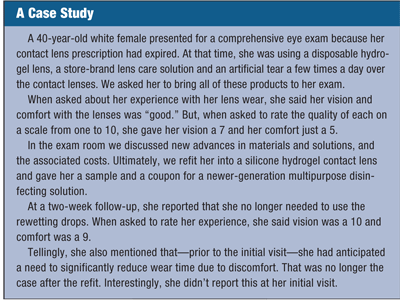I f your car’s gas gauge had merely two settings—“empty” and “full”—you’d be at a great disadvantage on the roads. Luckily, your dashboard includes a finely graduated scale that tells you how much you have in the tank at any moment. Wouldn’t it be great if our patients also gave us such precise information? Actually, they can, if you know how to ask.
f your car’s gas gauge had merely two settings—“empty” and “full”—you’d be at a great disadvantage on the roads. Luckily, your dashboard includes a finely graduated scale that tells you how much you have in the tank at any moment. Wouldn’t it be great if our patients also gave us such precise information? Actually, they can, if you know how to ask.
Because contact lens wear is a subjective experience, patient feedback is an essential tool that helps us fine-tune the results. If we can elicit specific, measurable data from patients, we stand a better chance of keeping them happy and healthy contact lens wearers. This month’s column will focus on how to quantify the factors that matter to patients—a critical yet underused tool that will help improve patient care by minimizing contact lens dropouts.
The Value Scale
From contact lens solutions and drops to major advances in materials and modalities, we have an unprecedented opportunity to make our patients comfortable in their lenses. When do you introduce these products to your patients?
 Think about the last few contact lens patients who visited your practice. Maybe they were using non-optimal solutions, materials and/or outdated lens design for their particular vision correction needs. When asked about their contact lens experience, did they reply with a vague “good” or “fine” as a response? These one-word answers that our patients use to describe their wearing experience make it difficult to understand what truly is happening.
Think about the last few contact lens patients who visited your practice. Maybe they were using non-optimal solutions, materials and/or outdated lens design for their particular vision correction needs. When asked about their contact lens experience, did they reply with a vague “good” or “fine” as a response? These one-word answers that our patients use to describe their wearing experience make it difficult to understand what truly is happening.
There are two key components to successful contact lens wear: vision and comfort.1,2 So, how can you get an accurate understanding of your patient’s wear experience? Instead of ambiguously asking your patient how his or her vision is, try to specifically ask about the quality of the vision. Even more helpful, ask your patient to quantify the quality of his or her vision and comfort level so you can determine whether there may be an opportunity for improvement.
Present your patient with a scale ranging from zero to 10 (with zero being vision without contact lenses and 10 being the best the vision can be). Then ask your patient to rank the overall quality of his or her vision. Similarly, next ask your patient to rank his or her comfort level in the lenses. Any score below a perfect 10 should jump-start a conversation on new ways you can improve your patient’s lens wearing experience.
Implementation
The importance of quantifying a patient’s experience through a scale can be seen in a number of instances. For example, the Ocular Surface Disease Index (OSDI) allows a patient to quantify his or her “level” of dry eye symptoms.3 Also consider that in clinical research, participants are often asked to quantify their experience with some scaling system to help expose differences that may exist between treatment groups. Why is that? Two individuals who may address directed questions with the same one-word answer, such as “good,” might respond very differently when given a scale to rate their experience. A scale helps us answer the follow-up question: How “good” was the experience?
If we can accurately understand our patient’s wear experience, we can better engage our patients in meaningful communication regarding new technologies in solutions, drops and lenses and their potential to improve comfort and vision.
A last word of advice: Follow up with your patient after you have changed some part of the lens regimen. We always begin by asking our patients to rate their experience with both their previous and their new regimens. This will give you a direct comparison to gauge the level of success or failure with the new option.
Quantifying a patient’s level of satisfaction or dissatisfaction with their lens-wearing experience creates a context for realistic discussions about their continued lens wear. Whether it is accomplished via a formal questionnaire that is completed with the history intake form or verbally with your paraoptometric or yourself, this information will give you a better understanding of your patient’s wearing experience and help derail dropouts.
1. Young G, Veys J, Pritchard N, Coleman S. A multi-centre study of lapsed contact lens wearers. Ophthalmic Physiol Opt. 2002 Nov;22(6):516-27.
2. Rumpakis JMB. New data on contact lens dropouts: an international perspective. Rev Optom. 2010 Jan;147(1):37-42.
3. Ocular Surface Disease Index. Allergan. 2005. Available at:
www.dryeyezone.com/documents/osdi.pdf. Accessed November 2012.


